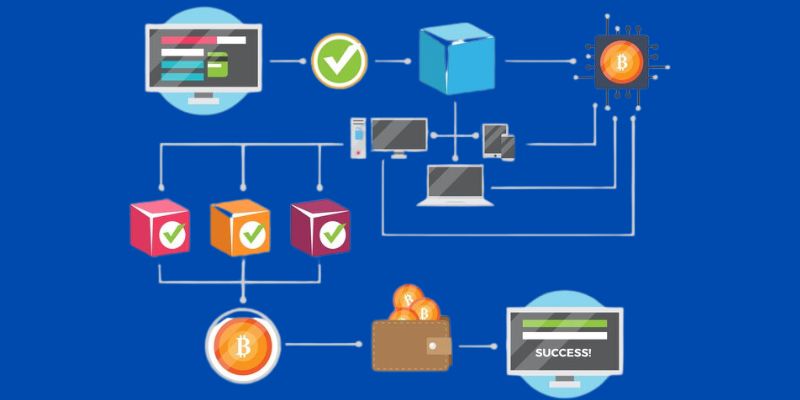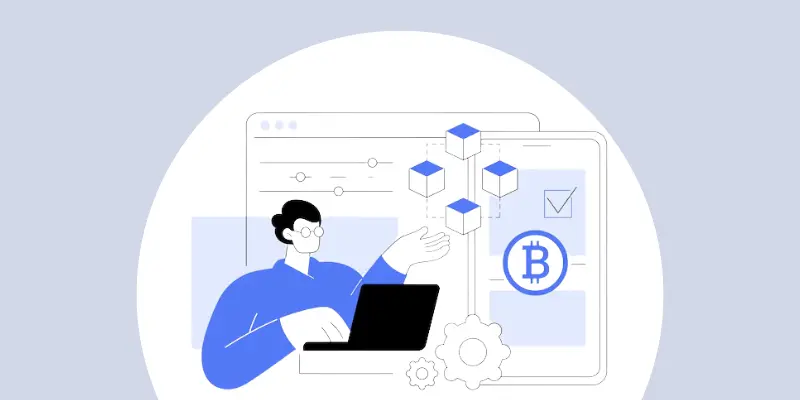Blockchain is an innovative invention that promises to make our digital lives safer and decentralized. If you are considering adopting this innovation into your business, then expert knowledge or guidance on blockchain app development is required for successful integration. Here, we have laid out all the steps required for developing such an app specific to your industry.
Blockchain has quickly gained popularity among developers and companies looking to streamline their processes, with applications for blockchain ranging from peer-to-peer lending platforms and cryptocurrency wallets to decentralized exchanges and cryptocurrency wallets gaining increasing traction in today's marketplace. Blockchain holds immense promise to revolutionize various industries, from finance and supply chain management systems to healthcare delivery systems - should you encounter any obstacles, professional blockchain app development services can always offer assistance if needed.
Also Read: Do you need programming skills for blockchain in 2024
What Are Blockchain Apps/DApps (or Distributed Application Platforms (DAPs)?
Blockchain applications, also referred to as decentralized apps, utilize blockchain technology. Decentralized apps operate using a distributed ledger system with linked blocks across multiple nodes storing information securely in linked blocks linked by smart contracts, making these secure, transparent, and censorship-free apps.
Blockchain technology can be used to build different kinds of apps, opening up endless opportunities for app development across industries. Blockchains can be used for virtually any type of app; however, they're most commonly employed for those that require high levels of security—financial services, supply chains, marketplaces, ID verification systems, healthcare, and so on—while less severe apps such as games and social networking sites may also use them for development.
Read About: Build a Blockchain App Tech and Business Guide to Follow
How Do Blockchain Applications Operate?
Before blockchain app development, let's explore how these apps operate. To comprehend how blockchain apps work entirely, one needs to know regular apps as a baseline comparison.
With traditional web applications, users simply access web pages with frontends built using HTML, CSS, and JavaScript code residing on web servers. A web app also communicates with its central backend database storage.
Blockchain apps resemble their counterparts in that their underlying infrastructure is similar, yet the data storage and retrieval method differs drastically. Instead of having all site information housed on one central server, all blockchain-based applications store all backend info on decentralized nodes.
Nodes on a blockchain network hold identical copies of its blockchain database, creating new blocks and validating transactions while working together to keep it current.
Transactions on blockchain apps are managed through smart contracts—self-executing instructions written into lines of code on the blockchain that execute when certain conditions are met. Their self-executing nature eliminates intermediaries or central authorities, as intermediary points of control are no longer needed for transaction management.
Blockchain apps rely heavily on decentralized storage. However, another critical building block of blockchain applications is the consensus mechanism, part of the blockchain network's algorithm for validating transactions and adding new blocks to the blockchain. Blockchain apps typically employ either proof-of-work or proof-of-stake consensus mechanisms, so all nodes agree on the validity of each transaction or block before adding them.
Must Read: What is The Cost For Developing A Blockchain Application
Blockchain Application Development Process

Digital ledger technologies continue to develop rapidly, with blockchain at the forefront. Breakthrough advancements regularly occur within this space, setting new security and efficiency standards.
Here are the essential steps and strategies that can help take your project from idea to implementation:
Analyzing the Market Understanding
Market dynamics is fundamental to successful blockchain app development. Prior to commencing development work on any new blockchain applications, a careful examination of current trends, user needs, and potential gaps must take place.
Researchers must conduct extensive market analyses, noting any strengths or weaknesses in existing blockchain solutions that may affect their application. Developers must conduct detailed comparative analyses.
Investigate regulatory frameworks influencing blockchain's applicability across various industries. Understanding these regulations will guide development into compliance and acceptance.
Engaging with the blockchain community can provide invaluable insight into user expectations, leading to applications that resonate with their intended target audiences. Staying abreast of technological advancements provides a competitive edge when it comes to application features and security.
Blockchain app development is an ambitious undertaking. It involves an intricate blend of creativity, market expertise, and foresight that culminates in a robust application designed for success in today's rapidly expanding digital economy.
Setting goals is at the core of every successful blockchain app development project. This allows for effective project scoping.
Goals can range from increasing transaction security and streamlining supply chain management to offering decentralized FinTech solutions. To effectively align all development efforts, it's essential that we identify the primary issue the blockchain solution intends to address.
Clear goals help create a targeted development roadmap and set realistic milestones. They also serve as a measure of success and give direction to development teams.
Whether your goals involve increasing transparency, reducing costs, or providing a user-friendly interface, they must all be specific, measurable, attainable, relevant, and timely (SMART). Well-defined goals ensure that blockchain applications offer tangible value to their end-users.
Selecting an Appropriate blockchain app development company is vital to designing applications tailored to your needs. Each platform offers different features, such as smart contracts, consensus mechanisms, and transaction speeds, which could prove essential in meeting those goals.
When making a selection, consider your platform's scalability, security features, and level of community support. Popular platforms like Ethereum are known for having extensive developer communities and resources available to them.
Your application's goals must align with its platform, whether supporting high transaction volumes or integrating with existing systems. Furthermore, it should support customizations as well as technological innovations.
Transaction costs (sometimes called gas fees) substantially influence application success; therefore, selecting an appropriate blockchain platform for use is key to building success in any app.
Brainstorming & Blockchain Ideation
The brainstorming and ideation phase is at the core of blockchain development, serving as an incubator for creative, practical, and groundbreaking ideas to blossom into fruition.
Teams should bring together diverse perspectives, encouraging a free flow of ideas, to assess blockchain technology's full potential. Through collaboration, unique use cases that could disrupt industries or enhance existing systems may emerge.
At these sessions, it is vitally essential that teams prioritize user-oriented solutions while considering technical feasibility. Utilizing market analysis insights, teams can identify opportunities where blockchain could offer significant benefits.
The outcome of this stage can significantly influence a blockchain development strategy; it establishes an innovative, feasible, and successful project.
Brainstorming sessions that challenge the status quo while keeping end-user value in mind tend to produce the best ideas.
Proof of Concept
A Proof of Concept (PoC) is an integral step in developing blockchain applications, as it serves as a prototype to demonstrate their feasibility and practical potential.
PoCs should address core functionality and demonstrate how blockchain can address a specific challenge or issue, allowing stakeholders to see its impact and evaluate its worth.
PoCs also help identify technical challenges early and allow adjustments before full-scale development starts. They serve as risk management tools that can save time and resources; when designed effectively, a well-crafted PoC can play an integral role in winning over executives or potential investors.
PoCs for blockchain app development serve not only as prototypes; they're proofs of value and capability that help guide a project's future path and scalability, bridging an idea with its realization in the blockchain world.
Establish the User Experience [UI/UX Design]
Crafting an application's user-experience design is key to its visual and functional user-friendliness, so designers must focus on crafting an intuitive interface that simplifies blockchain for users.
The goal of design is to promote effortless navigation and user journey, regardless of technical proficiency.
UX designers should map out user journeys to identify and eliminate any possible friction points. In turn, UX should reflect this purpose with an intuitive user experience that seamlessly interacts with blockchain features.
This process typically includes creating wireframes, prototypes, and user stories to test and enhance user experiences. An effective user experience design can significantly increase adoption and satisfaction among blockchain applications' target users, hence its inclusion as a crucial component in its creation.
Blockchain app development is where conceptualized blockchain solutions become tangible products. This involves programming an app, integrating blockchain with other technologies, and ensuring that all components work harmoniously together.
At this stage, a knowledgeable team of blockchain developers must be assembled. Each must possess expertise in blockchain technology and its related programming languages.
Careful attention must be taken during development to ensure security and functionality. Developers should conduct extensive tests of their applications for vulnerabilities as they often handle sensitive information or transactions.
Continuous integration and deployment practices can speed up this process, enabling real-time updates and quicker bug fixes. When building a blockchain app, it is vital to balance innovation, usability, and security.
Deployment & Release
Deployment and release are the last stages in blockchain app development, which involve launching your program live onto an active blockchain network.
Before release, final testing must take place to ensure all application components work as expected.
Implementation should encompass plans for scalability and maintenance that account for potential user growth and future updates. Monitoring tools should also be implemented to track performance metrics and user engagement levels.
Support systems must be put in place post-launch to address any potential issues as soon as they arise. At the same time, effective communication with the user base about new features or updates is vital.
An effective deployment and release sets the stage for application adoption and long-term success in the market.
Marketing & Promotion
Marketing and promotion are central to the success of any blockchain application. They play an essential role in increasing user adoption and creating awareness of its benefits and features. A sound marketing strategy should highlight these points of differentiation to ensure maximum impactful communication to target markets.
Reaching out to potential users and stakeholders can significantly boost visibility for blockchain technologies. Social media, blogs, and forums that focus on blockchain can assist in reaching a wider audience.
Collaborations with influential figures in the blockchain world can increase an application's visibility. Attending webinars and industry conferences provides invaluable networking opportunities.
A practical application must present an engaging narrative, clearly outlining its value proposition and potential impact. A smart marketing and promotional strategy will set your app apart in an already competitive marketplace and attract an avid user base.
An effective blockchain app development process can completely transform your digital strategy and establish the basis for future-proofing your technology investments.
Read Also: Blockchain Development a Must-Have in the Developer Toolkit
Blockchain Application Development Tools

Blockchain development necessitates specific tools to be efficient and effective. Selecting the appropriate set can make an immense difference to application quality.
Below are the essential tools every developer must keep in mind when blockchain app development:
Blockchain Testnet
A Blockchain Testnet is an invaluable tool for developers. It offers a safe environment for experimenting with blockchain code without compromising the leading network.
Utilizing a test net, developers can simulate transactions, test smart contracts, and debug systems before deploying applications, guaranteeing robust and error-free apps.
Metamask
Metamask is an essential tool for blockchain developers. It serves as an Ethereum wallet and gateway to Ethereum-based apps. This secure tool ensures the secure management of identities and transactions on the Ethereum network.
Integrating Ethereum into a browser simplifies interacting with its blockchain, making it accessible for developers and end-users alike.
Remix IDE
Remix IDE is a robust open-source tool used widely in Ethereum blockchain development. It facilitates writing, testing, and deploying smart contracts written in Solidity language directly in web browsers.
This tool is ideal for quick development cycles and features an intuitive user interface suitable for both novices and more seasoned developers alike.
EtherScripter
EtherScripter is essential to blockchain app development. It offers a visual interface for creating Ethereum smart contracts. Its user-friendly drag-and-drop approach mainly benefits beginners, making the complex coding process much less cumbersome.
This tool helps make smart contract creation simpler and blockchain application development more accessible to newcomers.
Geth
Geth, or Get Ethereum, is a command-line interface tool integral to Ethereum blockchain development. It enables developers to run a full node containing all aspects of an Ethereum node: mining Ether, creating smart contracts, and managing user accounts.
Geth is a gateway that enables developers to interact directly with the Ethereum blockchain and offers robust functionality.
Truffle
Truffle is an impressive development framework for Ethereum that simplifies smart contract creation, testing, and deployment. It offers tools for writing automated tests, managing dependencies, and deploying contracts quickly.
Truffle's integrated blockchain app development environment and asset pipeline provide blockchain developers with a smooth workflow experience, making it a crucial tool.
Solium
Solium (now Ethlint) is an essential tool in Ethereum blockchain app development. It enforces code style and security best practices within Solidity, the platform's primary programming language for smart contracts.
Solium ensures smart contracts are more secure, maintainable, and error-free by identifying and fixing security vulnerabilities and coding errors.
Mist
Mist is an Ethereum wallet and gateway for blockchain applications. It serves primarily as a browser for decentralized apps (dApps) and provides users with a user interface to securely manage Ethereum accounts and assets.
Mist allows users to interact directly with Ethereum's blockchain. Developers also use it as an effective testing and deployment platform for their dApps, making Mist an invaluable asset within the Ethereum ecosystem.
Embark
Embark is a reliable framework for creating decentralized apps on the Ethereum blockchain. It simplifies the deployment of smart contracts while automating testing and management processes.
Embark integrates seamlessly with Ethereum blockchain, IPFS, and other decentralized storage platforms, providing an essential tool for quickly building and managing complex dApps efficiently.
GanacheCLI
GanacheCLI (formerly TestRPC) is an integral component of the Ethereum developer toolkit. It is used to create personal blockchains with Ganache.
This tool allows developers to test smart contracts and dApps in a controlled, safe environment. It simulates complete client behavior, making it invaluable during development, testing, and debugging.
Tools are essential in crafting secure and scalable blockchain apps. They facilitate blockchain app development processes and guarantee a smooth project outcome.
Conclusion
Constructing an efficient blockchain application ensures secure and transparent transactions, but it's high demand requires secure, user-centric, and advanced technology solutions. Enlist all essential features, factors, and steps when developing a Blockchain project to save yourself valuable resources, such as time and effort, while providing optimal protection to your target audience.
Custom blockchain app development can bring many advantages, but creating it may be challenging. But with the right team and experts, this challenge can become an opportunity for growth.













Share this blog